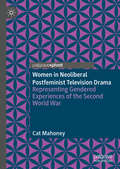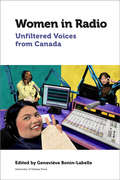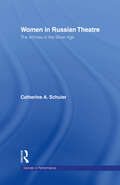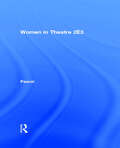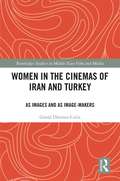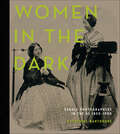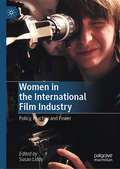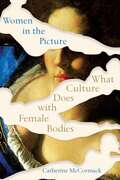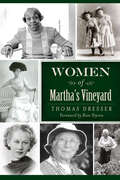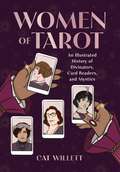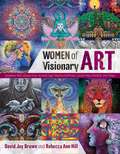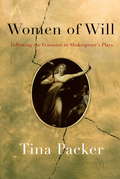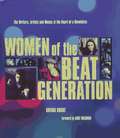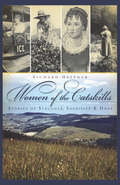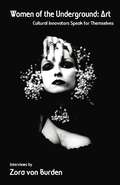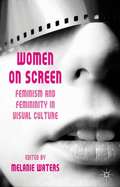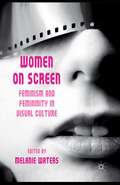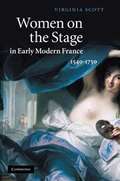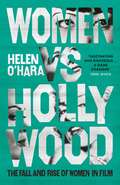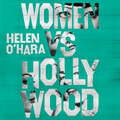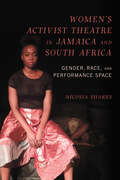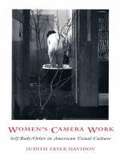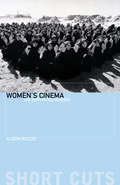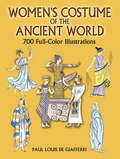- Table View
- List View
Women in Neoliberal Postfeminist Television Drama: Representing Gendered Experiences of the Second World War
by Cat Mahoney“In this insightful book, Cat Mahoney offers a fascinating analysis of contemporary TV dramas such as Home Fires, Land Girls and The Bletchley Circle. Developing the idea that history is told through the preoccupations of the present, she argues compellingly that these are postfeminist dramas which work through troubling ideas about heteronormative romance, domesticity, beauty and whiteness, while reinforcing the idea that feminism as a political movement is not necessary. A bold and original contribution to television studies, gender studies and popular history.” ̶ Rosalind Gill, City, University of London, UK By examining contemporary television drama set during and immediately after the Second World War, this book illustrates the ways in which postfeminism has shaped representations of women in contemporary culture. Mahoney offers a new perspective to debates that have previously been concerned with questions of historical accuracy. She argues that depictions of women from the past in modern television drama spawn from the neoliberal postfeminist media climate which originated in the 1990s. These depictions respond to a cultural need to naturalise and de-historicise a version of neoliberal postfeminist femininity that is compatible with the current media climate and far more reflective of the concerns of the present than any “real” or lived experience of women in the past. The result of this process of naturalisation is the assertion that postfeminist values are natural and eternal, rather than a product of the 1980s economic turn and the present political moment. By identifying and interrogating postfeminist norms within four television drama series produced since the 2008 financial crash, this book argues that postfeminism is a dominant structuring force in their depiction of female characters and of the past.
Women in Radio: Unfiltered Voices from Canada (Canadian Studies)
by Linda Kay Gregory Taylor Angela Wilson Anna Leventhal Helen Aitkin Constance Dilley Barbara M. Freeman Chantal Dumas Helen Hambly Christine Maki Andra McCartney Catherine McInnis Tanis Mcknight-Howe Lise Millette Ross E. Perigoe Gertrude J. Robinson Patti Schmidt Anita Marie Slominska Sophie Toupin Marian van der ZonWho are, au féminin, the legends who shaped radio in Canada? What did they contribute locally, regionally, and nationally? How was their experience in radio broadcasting different from that of their male counterparts? Women in Radio presents the women who built careers in the radio industry—yet whose contribution has often been overlooked simply because they were women. This collection of stories highlights the multi-faceted contributions they made to their field and explores issues specific to them. Academic research, interviews, personal reflections and accounts, historical reviews, and hybrid texts combine neatly in this eclectic yet well–researched edited volume to reflect the fast-paced world of radio broadcasting. Whether through storytelling, direct quotes, or quasi transcriptions best read aloud, the reader will come away with a real sense of the aural nature of radio, of the voice unaccompanied, of the pure spoken word and how it differs from the printed word. Published in English.
Women in Russian Theatre: The Actress in the Silver Age (Gender in Performance)
by Catherine SchulerWomen in Russian Theatre is a fascinating feminist counterpoint to the established area of Russian theatre populated by male artists such as Stanislavsky, Chekov and Meyerhold. With unprecedented access to newly-opened files in Russia, Catherine Schuler brings to light the actresses who had an impact upon Russian modernist theatre. Schuler brings to light the extradordinary lives and work of eight Russian actresses who flourished on the stage between the late nineteenth and early twentieth century.
Women in Theatre 2#3 (Contemporary Theatre Review Ser.)
by Julia PascalFirst Published in 1996. Routledge is an imprint of Taylor & Francis, an informa company.
Women in the Cinemas of Iran and Turkey: As Images and as Image-Makers (Routledge Studies in Middle East Film and Media)
by Gonul Donmez-ColinThis volume compares the cinemas of Iran and Turkey in terms of the presence and absence of women on both sides of the camera. From a critical point of view, it provides detailed readings of works by both male and female film-makers, emphasising issues facing women's film-making. Presenting an overview of the modern histories of the two neighbouring countries the study traces certain similarities and contrasts, particularly in the reception, adaption and representation of Western modernity and cinema. This is followed by the exploration of the images of women on screen with attention to minority women, investigating post-traumatic cinema's approaches to women (Islamic Revolution of 1979 in Iran and the 1980 coup d’état in Turkey) and women's interpretations of post-traumatic experiences. Furthermore, the representations of sexualities and LGBTI identities within cultural, traditional and state-imposed restrictions are also discussed. Investigating border-crossing in physical and metaphorical terms, the research explores the hybridities in the artistic expressions of 'deterritorialized' film-makers negotiating loyalties to both vatan (motherland) and the adopted country. This comprehensive analysis of the cinemas of Iran and Turkey, based on extensive research, fieldwork, interviews and viewing of countless films is a key resource for students and scholars interested in film, gender and cultural studies and the Middle East.
Women in the Dark: Female Photographers in the US 1850–1900
by Katherine ManthorneBrings to light the hidden histories of two generations of women photographers in 19th-century AmericaFor all interested in photographic, 19th-century American, and women's historyIncludes stories of amazing ingenuity, including using a skirt as a &“portable darkroom&”
Women in the International Film Industry: Policy, Practice and Power
by Susan LiddyThe chapter Experiencing Male Dominance in Swedish Film Production” is available open access under a Creative Commons Attribution 4.0 International License via link.springer.com.
Women in the Picture: What Culture Does With Female Bodies
by Catherine McCormackArt historian Catherine McCormack challenges how culture teaches us to see and value women, their bodies, and their lives. Venus, maiden, wife, mother, monster—women have been bound so long by these restrictive roles, codified by patriarchal culture, that we scarcely see them. Catherine McCormack illuminates the assumptions behind these stereotypes whether writ large or subtly hidden. She ranges through Western art—think Titian, Botticelli, and Millais—and the image-saturated world of fashion photographs, advertisements, and social media, and boldly counters these depictions by turning to the work of women artists like Morisot, Ringgold, Lacy, and Walker, who offer alternative images for exploring women’s identity, sexuality, race, and power in more complex ways.
Women of Martha's Vineyard (American Heritage Ser.)
by Thomas DresserGenerations of women have traveled to Martha's Vineyard to find solace in its calming waves and varied shoreline. Many prominent and capable women set down roots, contributing to the fabric of the community on the island. Learn of the brilliant poet Nancy Luce, who lived in isolation with her chickens. Emily Post, whose name is synonymous with good manners, sought respite from her personal struggles on the Vineyard. Famed horticulturalist Polly Hill left a perennial legacy for islanders with her tranquil arboretum. In the twentieth century, novelist Dorothy West captured the beauty of Martha's Vineyard with her work. Historian Thomas Dresser provides a series of biographical sketches of these extraordinary women who were bound by their love of the island.
Women of Tarot: An Illustrated History of Divinators, Card Readers, and Mystics
by Cat WillettDiscover the hidden stories of tarot and divination—traced through the lives and contributions of Lady Frieda Harris, Marie Anne Lenormand, Pamela Colman Smith, and Rachel Pollack—in this vividly illustrated popular history of the cards. Tarot's storied history takes us from the highest circles of Italian Renaissance society through to present day card creators. And throughout that time, women have been the primary drivers of both artistic and magical innovation in the form, though they haven't always been given adequate credit for doing so. Now, for the first time, readers can explore the lives and work of some of the women who have brought us the word's most popular divinatory art. In Women of Tarot celebrated artist and author Cat Willett traces the lives of four women who have pioneered work in tarot and divination. There is Lady Frieda Harris, the nineteenth century British artist and mystic who created the Thoth Tarot with the occultist Aleister Crowley, and Marie Anne Lenormand, the most celebrated fortune teller of eighteenth century France, who brought card reading to the masses. Then readers will meet Pamela Colman Smith, the iconic cross-continental artist whose illustrations adorn the world's most popular tarot deck—the Rider-Waite-Smith Deck—and finally Rachel Pollack, the trans woman responsible for creating scores of decks in her lifetime, as she strove to make tarot an art that was inclusive of all practitioners, especially the LGBTQIA+ community. Woven throughout is a timeline of the development of tarot, as well as miniature profiles of women from cultures around the world whose work has impacted divination and fortune telling, including Nefertiti, Voodoo Queen of New Orleans Marie Laveau, author Zora Neale Hurston, and contemporary artist Nanse Kawashima.
Women of Visionary Art
by David Jay Brown Rebecca Ann HillAn exploration of the role that dreaming, psychedelic experiences, and mystical visions play in visionary art • Includes discussions with 18 well-known female artists, including Josephine Wall, Allyson Grey, Amanda Sage, Martina Hoffmann, Penny Slinger, and Carolyn Mary Kleefeld • Reveals how they have all been inspired by deep inner experiences and seek to express non-ordinary visions of reality, reminiscent of shamanic trance states, lucid dreams, and spiritually transcendent experiences • Shows how visionary art often contains an abundance of feminine energy, helping us to heal ourselves and see that we are all connected Since early humans first painted from their mystic eye onto cave walls, artists have sought to share their sacred visions with the world. Created in every medium, from oil painting and sculpture to contemporary digital modeling, these visionary works of art give those who experience them a chance to “see the unseen,” realize wider modes of perception, and discover spiritual and mystical realms. In this full-color illustrated book, David Jay Brown and Rebecca Ann Hill examine the work and inspirations of eighteen of today’s leading female visionary artists, including Josephine Wall, Allyson Grey, Amanda Sage, Martina Hoffmann, Penny Slinger, and Carolyn Mary Kleefeld. They explore the creative process and the role that dreaming, psychedelic experiences, sexuality, and divine guidance play in the work of these women, alongside full-color examples of their art. They discuss the future of visionary art and reveal how these artists have all been informed and inspired by deep inner experiences and seek to express non-ordinary visions of reality, often reminiscent of those encountered in shamanic trance, lucid dreams, psychedelic states, spiritually transcendent experiences, and other altered states. Showing how visionary art often contains an abundance of feminine energy, helping us to heal ourselves and see that we are all connected, the authors explore with each artist what it is about being a woman that has most influenced their artwork. They also examine the connection between visionary art and spirituality, the influence of Nature and sacred geometry, and how this creative form is simultaneously ancient, futuristic, and timeless, providing an accessible doorway into the visionary realm.
Women of Will
by Tina PackerFrom one of the country's foremost experts on Shakespeare and theatre arts, actor, director, and master teacher Tina Packer offers an exploration--fierce, funny, fearless--of the women of Shakespeare's plays. A profound, and profoundly illuminating, book that gives us the playwright's changing understanding of the feminine and reveals some of his deepest insights. Packer, with expert grasp and perception, constructs a radically different understanding of power, sexuality, and redemption. Beginning with the early comedies (The Taming of the Shrew, Two Gentlemen of Verona, The Comedy of Errors), Packer shows that Shakespeare wrote the women of these plays as shrews to be tamed or as sweet little things with no definable independent thought, virgins on the pedestal. The women of the histories (the three parts of Henry VI; Richard III) are, Packer shows, much more interesting, beginning with Joan of Arc, possibly the first woman character Shakespeare ever created. In her opening scene, she's wonderfully alive--a virgin, true, sent from heaven, a country girl going to lead men bravely into battle, the kind of girl Shakespeare could have known and loved in Stratford. Her independent resolution collapses within a few scenes, as Shakespeare himself suddenly turns against her, and she yields to the common caricature of his culture and becomes Joan the Enemy, the Warrior Woman, the witch; a woman to be feared and destroyed . . . As Packer turns her attention to the extraordinary Juliet, the author perceives a large shift. Suddenly Shakespeare's women have depth of character, motivation, understanding of life more than equal to that of the men; once Juliet has led the way, the plays are never the same again. As Shakespeare ceases to write about women as predictable caricatures and starts writing them from the inside, embodying their voices, his women become as dimensional, spirited, spiritual, active, and sexual as any of his male characters. Juliet is just as passionately in love as Romeo--risking everything, initiating marriage, getting into bed, fighting courageously when her parents threaten to disown her--and just as brave in facing death when she discovers Romeo is dead. And, wondering if Shakespeare himself fell in love (Packer considers with whom, and what she may have been like), the author observes that from Juliet on, Shakespeare writes the women as if he were a woman, giving them desires, needs, ambition, insight.Women of Will follows Shakespeare's development as a human being, from youth to enlightened maturity, exploring the spiritual journey he undertook. Packer shows that Shakespeare's imagination, mirrored and revealed in his female characters, develops and deepens until finally the women, his creative knowledge, and a sense of a larger spiritual good come together in the late plays, making clear that when women and men are equal in status and sexual passion, they can--and do--change the world. Part master class, part brilliant analysis--Women of Will is all inspiring discovery.From the Hardcover edition.
Women of the Beat Generation: The Writers, Artists and Muses at the Heart of a Revolution
by Brenda A. KnightA well-researched book brings to light the fact that the Beat Generation involved women too. This book narrates the sad stories of women married to Beat Poets.
Women of the Catskills: Stories of Struggle, Sacrifice & Hope (American Chronicles)
by Richard HeppnerHailing from the home of industrious, strong and creative individuals, the women of the Catskills have embodied this rugged spirit best. Though often overlooked in Catskill Mountain history, their stories are inspiring, like that of Candace Wheeler, who used her rural upbringing to achieve personal success and improve life for others. They are personal, such as Lucy Lobdell's story. A century ahead of her time, she challenged conventional thoughts on equality and lifestyle. Most of all, they reflect the spirit of their surroundings, as independent women like Marion Bullard challenged the status quo to build a better community. Overcoming the physical challenges of mountain life and the societal obstacles they faced because of their gender, Catskills' most fearless women are revealed by local historian Richard Heppner.
Women of the Underground: Art
by Zora Von Burden"It is not about provocation, reaction or even invocation, it is about transformation: mentally and physically."--Marina Abramovic, artist"Art is subjective, and if one sees something in an image, that projection is a reflection of the spectator, who sees what he or she wants to see, whose critique is relevant to him or herself, exposing his or her own perversions."--Irina Ionesco, artistUntil the late twentieth century, women's creative skills were relegated to craft and decorative arts, and valued only for utilitarian purposes in service to others and the manufacturing of products to benefit society.After enduring the great injustice of being denied the freedom that self-expression brings through art for the joy of the human spirit, Women of the Underground: Art celebrates those female cultural innovators who are creating new artwork that pushes boundaries, dares to question, and redefines the genres of mixed media; theater; film; photography; and visual, conceptual, and performance art.In this groundbreaking anthology that will inspire artists and everyone interested in alternatives to mainstream culture, as well as serve as a reference book for art historians, twenty-six female artists describe their ideas, beginnings, influences, and creative techniques. Contains interviews with Lady Pink, Marina Abramovic, Orlan, Aleksandra Mir, Penny Arcade, Johanna Went, the Guerrilla Girls, and many others.Editor Zora von Burden was born and raised in San Francisco, California. A frequent contributor to The San Francisco Herald, von Burden also wrote the screenplay for Geoff Cordner's underground cult classic film, Hotel Hopscotch.
Women on Screen
by Melanie WatersA timely intervention into debates on the representation of feminist and feminine identities in contemporary visual culture. The essays in this collection interrogate how and why certain formulations of feminism and femininity are currently prevalent in mainstream cinema and television, offering new insights into postfeminist media phenomena.
Women on Screen: Feminism and Femininity in Visual Culture
by Melanie WatersA timely intervention into debates on the representation of feminist and feminine identities in contemporary visual culture. The essays in this collection interrogate how and why certain formulations of feminism and femininity are currently prevalent in mainstream cinema and television, offering new insights into postfeminist media phenomena.
Women on the Stage in Early Modern France: 1540-1750
by Virginia ScottFocusing on actresses in France during the early modern period, Virginia Scott examines how the stereotype of the actress has been constructed. The study then moves beyond that stereotype to detail the reality of the personal and artistic lives of women on the French stage, from the almost unknown Marie Ferr_ - who signed a contract for 12 livres a year in 1545 to perform the 'antiquailles de Rome or other histories, moralities, farces, and acrobatics' in the provinces - to the queens of the eighteenth-century Paris stage, whose 'adventures' have overshadowed their artistic triumphs. The book also investigates the ways in which actresses made invaluable contributions to the development of the French theatre in the seventeenth and eighteenth centuries, and looks at the 'afterlives' of such women as Armande B_jart, Marquise Du Parc, Charlotte Desmares, Adrienne Lecouvreur, and Hippolyte Clairon in biographies, plays, and films.
Women vs Hollywood: The Fall and Rise of Women in Film
by Helen O'Hara'A fascinating polemic' Sunday Times 'A powerful, sobering and vital work' The Mail on Sunday 'A page-turning read, peppered with humour' Sight & Sound'A must read' Edgar Wright A call to arms from Empire magazine's 'geek queen', Helen O'Hara, that explores women's roles - both in front of and behind the camera - since the birth of Hollywood, how those roles are reflected within wider society and what we can do to level the playing field. Hollywood was born just over a century ago, at a time of huge forward motion for women's rights. With no rules in place to stop them, there were women who forged ahead in many areas of filmmaking. Yet, despite the work of early pioneers like Dorothy Arzner, Mabel Normand, Mary Pickford and Alice Guy-Blaché, it soon came to embody the same old sexist standards. Women found themselves fighting a system that fed on their talent, creativity and beauty but refused to pay them the same respect as their male contemporaries - until now . . . The tide has finally begun to turn. A new generation of women, both in front of and behind the camera, are making waves in the industry and are now shaping some of the biggest films to hit our screens. In Women vs Hollywood: The Fall and Rise of Women in Film, film critic Helen O'Hara takes a closer look at the pioneering and talented women of Hollywood and their work in film since Hollywood began. And in understanding how women were largely written out of Hollywood's own origin story, and how the films we watch are put together, we can finally see how to put an end to a picture that is so deeply unequal - and discover a multitude of stories out there just waiting to be told.
Women vs Hollywood: The Fall and Rise of Women in Film
by Helen O'Hara'A fascinating polemic' Sunday Times'A game changer . . . as inspiring as it is informative' Terri White, editor-in-chief of Empire'An enlightening page-turner' Anna Smith, host of the Girls On Film podcast'This is the film history we need' Pamela Hutchinson, film historian and critic A call to arms from Empire magazine's 'geek queen', Helen O'Hara, that explores women's roles - both in front of and behind the camera - since the birth of Hollywood, how those roles are reflected within wider society and what we can do to level the playing field.The dawn of cinema was a free-for-all, and there were women who forged ahead in many areas of filmmaking. Early pioneers like Dorothy Arzner (who invented the boom mic, among other innovations) and Alice Guy-Blaché shaped the way films are made. But it wasn't long before these talented women were pushed aside and their contributions written out of film history. How and why did this happen?Hollywood was born just over a century ago, at a time of huge forward motion for women's rights, yet it came to embody the same old sexist standards. Women found themselves fighting a system that feeds on their talent, creativity and beauty but refuses to pay them the same respect as their male contemporaries - until now...The tide has finally begun to turn. A new generation of women, both in front of and behind the camera, are making waves in the industry and are now shaping some of the biggest films to hit our screens. There is plenty of work still needed before we can even come close to gender equality in film - but we're finally headed in the right direction.In Women vs Hollywood: The Fall and Rise of Women in Film, Empire's 'geek queen' Helen O'Hara takes a closer look at the pioneering and talented women of Hollywood and their work in film since Hollywood began. Equal representation in film matters because it both reflects and influences wider societal gender norms. In understanding how women were largely written out of Hollywood's own origin story, and how the films we watch are put together, we can finally see how to put an end to a picture that is so deeply unequal - and discover a multitude of stories out there just waiting to be told.
Women vs Hollywood: The Fall and Rise of Women in Film
by Helen O'Hara'A fascinating polemic' Sunday Times 'A powerful, sobering and vital work' The Mail on Sunday 'A page-turning read, peppered with humour' Sight & Sound'A must read' Edgar Wright A call to arms from Empire magazine's 'geek queen', Helen O'Hara, that explores women's roles - both in front of and behind the camera - since the birth of Hollywood, how those roles are reflected within wider society and what we can do to level the playing field. Hollywood was born just over a century ago, at a time of huge forward motion for women's rights. With no rules in place to stop them, there were women who forged ahead in many areas of filmmaking. Yet, despite the work of early pioneers like Dorothy Arzner, Mabel Normand, Mary Pickford and Alice Guy-Blaché, it soon came to embody the same old sexist standards. Women found themselves fighting a system that fed on their talent, creativity and beauty but refused to pay them the same respect as their male contemporaries - until now . . . The tide has finally begun to turn. A new generation of women, both in front of and behind the camera, are making waves in the industry and are now shaping some of the biggest films to hit our screens. In Women vs Hollywood: The Fall and Rise of Women in Film, film critic Helen O'Hara takes a closer look at the pioneering and talented women of Hollywood and their work in film since Hollywood began. And in understanding how women were largely written out of Hollywood's own origin story, and how the films we watch are put together, we can finally see how to put an end to a picture that is so deeply unequal - and discover a multitude of stories out there just waiting to be told.
Women's Activist Theatre in Jamaica and South Africa: Gender, Race, and Performance Space (NWSA / UIP First Book Prize)
by Nicosia M. ShakesTheater is an essential theoretical and practical site for forging Black radical thought, Africana feminisms, and womanism. Nicosia M. Shakes draws on ethnographic research in Jamaica and South Africa to analyze the vital relationship between activism and theater production. Concentrating on four performance events, Shakes situates the work of theater groups and projects within a trajectory of women-led social justice movements established in Jamaica, South Africa, and globally from the early 2000s to the present. Her analysis reveals movements driven by Black women’s artistic, intellectual, and organizational labor and focused on issues that range from sexual violence to reproductive justice to the spatial manifestations of racial, gender, and economic oppression. Shakes shows how theater’s political and pedagogical roles become entangled with histories and geographies of oppression and resistance; the identities and connections created by movements of people in the context of colonial and settler colonial histories; and ideas of womanism and feminism.
Women's Camera Work: Self/Body/Other in American Visual Culture
by Judith Fryer DavidovWomen's Camera Work explores how photographs have been and are used to construct versions of history and examines how photographic representations of otherness often tell stories about the self. In the process, Judith Fryer Davidov focuses on the lives and work of a particular network of artists linked by time, interaction, influence, and friendship--one that included Gertrude Käsebier, Imogen Cunningham, Dorothea Lange, and Laura Gilpin.Women's Camera Work ranges from American women's photographic practices during the nineteenth and early twentieth centuries to a study of landscape photography. Using contemporary cultural studies discourse to critique influential male-centered historiography and the male-dominated art world, Davidov exhibits the work of these women; tells their absorbing stories; and discusses representations of North American Indians, African Americans, Asian Americans, and the migrant poor. Evaluating these photographers' distinct contributions to constructions of Americanness and otherness, she helps us to discover the power of reading images closely, and to learn to see through these women's eyes.In presenting one of the most important strands of American photography, this richly illustrated book will interest students of American visual culture, women's studies, and general readers alike.
Women's Cinema: The Contested Screen (Short Cuts)
by Alison ButlerWomen's Cinema provides an introduction to critical debates around women's filmmaking and relates those debates to a variety of cinematic practices. Taking her cue from the groundbreaking theories of Claire Johnston, Alison Butler argues that women's cinema is a minor cinema that exists inside other cinemas, inflecting and contesting the codes and systems of the major cinematic traditions from within. Using canonical directors and less established names, ranging from Chantal Akerman to Moufida Tlatli, as examples, Butler argues that women's cinema is unified in spite of its diversity by the ways in which it reworks cinematic conventions.
Women's Costume of the Ancient World: 700 Full-Color Illustrations (Dover Pictorial Archive Ser.)
by Paul Louis de GiafferriOne of the most extensive pictorial collections of its kind, this volume of 700 full-color illustrations provides an authentic and fascinating glimpse of what fashionable women were wearing more than 2,000 years ago. Like many of today's young ladies, fashionably dressed women of ancient Egypt favored pointed sandals and dresses of transparent materials. Off-the-shoulder gowns were popular, as was costume jewelry. Assyrian females liked fringed accents on their tunics and gowns, while Greek and Roman ladies of fashion were partial to loose robes that frequently revealed upper and lower limbs. Head coverings from helmets and shawls to wide-brimmed hats were de rigueur. Organized according to region--Egyptian, Assyrian, Greek, Roman, and Greco-Roman--the finely detailed drawings are accompanied by brief identifying captions.A valuable reference for costume historians and designers, this extensive pictorial collection will delight fashion enthusiasts as well.
